Part Five in the Great Traditions of Chinese Cuisine series

Introduction to Jiangsu Food
Few culinary traditions balance elegance and flavour as skillfully as Jiangsu food, particularly the Great Tradition of Huaiyang Cuisine. This cuisine is known for its silky textures, subtle sweetness, and meticulously crafted dishes, which transform simple ingredients into works of art.
Originating in Jiangsu province, Huaiyang cuisine takes its name from the regions surrounding the Huai and Yangtze Rivers, particularly the cities of Huai’an, Yangzhou, and Zhenjiang. This fertile landscape, dotted with lakes and crisscrossed by waterways, provides an abundance of fresh produce, seafood, and aquatic vegetables. During the Qing Dynasty, the frequent travels of Emperors Kangxi and Qianlong through the region further elevated Huaiyang cuisine’s national prominence, cementing its status as a culinary tradition fit for royalty.
This post marks the fifth installment in the Great Traditions of Chinese Cuisine series, following explorations of Sichuan, Shandong, and Cantonese cuisines. As we delve into the world of Huaiyang cuisine, we’ll explore its defining characteristics, from key ingredients and signature dishes to the precise knife skills and delicate cooking techniques that continue to shape its enduring prestige.
Jiangsu’s Geographical and Cultural Context

The Geography of Jiangsu
Jiangsu province, located along China’s eastern coast, is defined by its waterways and fertile plains. Bordered by the Yellow Sea to the east, Jiangsu is traversed by two of China’s most significant rivers—the Yangtze and the Huai. The Grand Canal is an ancient engineering marvel connecting Beijing and Hangzhou. It also cuts through the province, facilitating trade and cultural exchange for centuries. This network of rivers, lakes, and canals, combined with Jiangsu’s mild, temperate climate, supports an abundance of seafood, aquatic vegetables, and lush produce, shaping the foundation of Huaiyang cuisine.

History and Culinary Refinement
Jiangsu’s historical and cultural significance further enriched its culinary landscape. Nanjing, the province’s capital, was once the political heart of several Chinese dynasties, including the Ming. Its name, meaning “South Capital,” contrasts with Beijing, the “North Capital,” highlighting its prominence in Chinese history. This imperial influence fostered culinary refinement, as elaborate banquets and elegant dishes became symbols of status and hospitality. The cities of Yangzhou, Huai’an, and Suzhou also played pivotal roles. These cities developed regional specialties that collectively form the backbone of Huaiyang cuisine. Yangzhou, in particular, was renowned during the Qing Dynasty. It was a hub for culture and gastronomy, frequented by emperors Kangxi and Qianlong on their southern tours.
Seasonality: A Culinary Calendar
Huaiyang cuisine is deeply tied to the seasons, with chefs prioritizing fresh, seasonal ingredients that reflect nature’s changing bounty. In Jiangsu, each season brings a distinct set of flavours and textures. Dishes are carefully adapted to highlight the best of what the land and waterways provide.
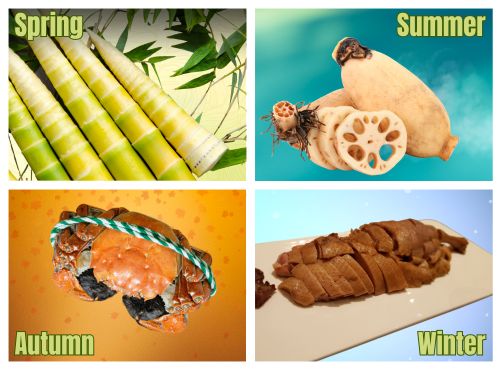
In Spring, tender bamboo shoots, fresh peas, and wild herbs feature prominently. These ingredients are often stir-fried lightly or served in delicate broths to preserve their crispness and vibrant colour. Summer introduces cooling dishes, such as chilled lotus root salad and light seafood preparations, including white-boiled shrimp and steamed river fish, designed to refresh the palate during the warmer months.
Autumn is celebrated as the season of harvest. The autumn months bring the highly prized Yangcheng Lake hairy crab, a delicacy known for its rich, buttery roe. This seasonal treasure is traditionally served steamed with ginger-infused black vinegar to accentuate its natural sweetness. Winter, in contrast, calls for heartier fare. Examples include braised pork belly and slow-cooked soups. Nanjing salted duck is a dish cured during the cooler months to achieve its signature tenderness and depth of flavour.
Seasonality extends beyond ingredients to cooking techniques and presentation. Light steaming and quick stir-frying dominate warmer months, while slow braising and stewing become more common in the colder seasons. This seasonal approach not only enhances taste and texture but also aligns with traditional Chinese beliefs about food’s role in balancing the body’s energy, or qi, throughout the year.
Key Flavours and Ingredients in Huaiyang Cuisine
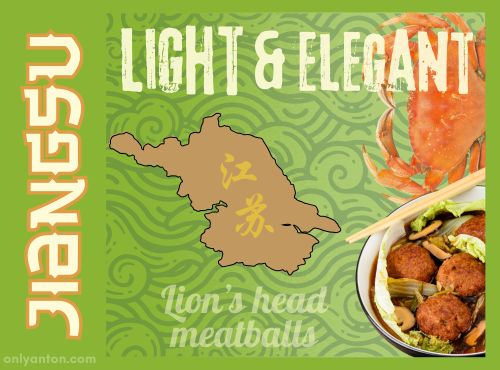
Huaiyang cuisine, the heart of Jiangsu’s culinary tradition, is defined by its light and elegant flavours. Dishes emphasize freshness, purity, and natural taste, with delicate seasoning that enhances rather than masks ingredients. This refined approach reflects the elegance of Jiangnan culture. Food is treated as an art form, balancing texture, aroma, and presentation with precision.
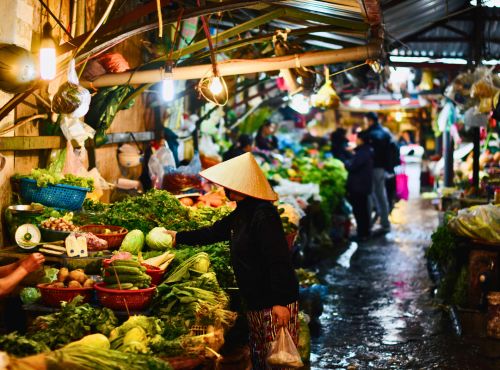
Key Ingredients in Huaiyang Cuisine
- Seafood and Freshwater Fish: Given Jiangsu’s extensive waterways, fish and shellfish are central to Huaiyang cuisine. Freshwater fish like mandarin fish, river eel, and the prized hairy crab from Yangcheng Lake are staples, often steamed or braised to preserve their delicate textures.
- Seasonal Vegetables: Jiangsu’s fertile plains yield a bounty of seasonal produce. Bamboo shoots, water chestnuts, lotus root, and snow peas frequently feature in Huaiyang dishes. Preparation methods are chosen to highlight each vegetable’s natural flavour and texture.
- Pork and Poultry: While seafood dominates, pork, duck, and chicken also hold prominent places. These proteins are often slow-cooked using methods like braising to ensure tenderness while allowing the dish’s seasonings to shine.
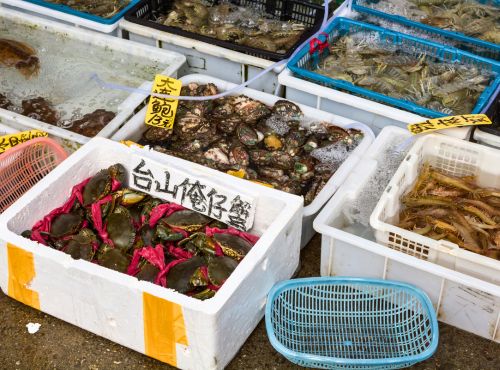
Zhenjiang Vinegar: The Signature Flavour Boost
A standout ingredient in Huaiyang cuisine is Zhenjiang vinegar (镇江香醋), a rice-based black vinegar renowned for its rich, mellow complexity. Produced in the city of Zhenjiang, this vinegar offers a perfect balance of acidity, sweetness, and umami. The vinegar enhances dishes without overpowering them. It’s commonly used in braised dishes, dipping sauces, and cold appetizers, where its smooth tang elevates the dish’s overall flavour profile.

For example, Squirrel Fish (Songshu Guiyu) is a famous Huaiyang dish featuring deep-fried mandarin fish. Zhenjiang vinegar is an essential component of the glossy sweet-and-sour sauce that coats the crispy fish, adding depth and brightness to every bite.
Ultimately, Jiangsu cuisine reflects the elegance of Jiangnan culture. Culinary artistry transforms the light, elegant flavours of seasonal ingredients into visually stunning and harmonious dishes.
Signature Huaiyang Dishes
Huaiyang cuisine is renowned not only for its elegant presentation and delicate flavours but also for its iconic dishes. Each dish reflects the region’s rich culinary heritage and meticulous craftsmanship. From festive banquets to humble street-side stalls, these signature dishes capture the essence of Jiangsu food.
1. Lion’s Head Meatballs (狮子头, Shīzitóu)
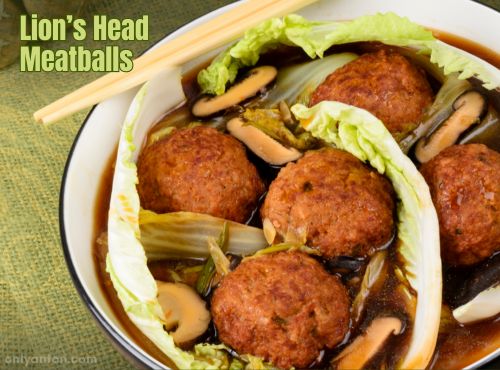
A true testament to Huaiyang’s emphasis on texture and subtle seasoning, Lion’s Head Meatballs are large, tender pork meatballs. They are often steamed or braised and served in a light, clear broth. The meat is finely minced to achieve an almost velvety consistency, then seasoned with ginger, scallions, and Shaoxing wine. The dish’s name stems from the meatballs’ resemblance to a lion’s head, symbolizing strength and prosperity. The meatballs are served with napa cabbage in some variations, representing the lion’s flowing mane.
2. Yangzhou Fried Rice (扬州炒饭, Yángzhōu Chǎofàn)
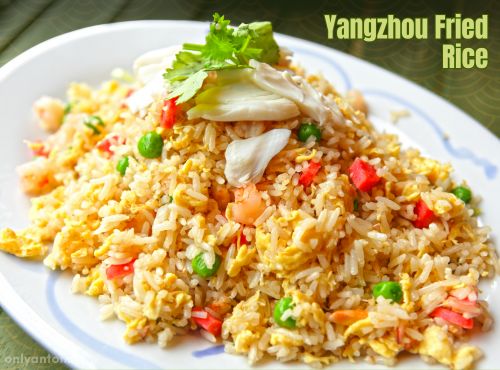
Hailing from the city of Yangzhou, this delicious fried rice is known for its precise knife work and harmonious balance of flavours. Each grain of rice remains separate yet tender, while finely diced shrimp, ham, peas, carrots, and eggs create a colourful, textural contrast. While it appears simple, achieving the perfect Yangzhou Fried Rice requires skillful control of heat and timing, ensuring the ingredients are lightly sautéed to retain their freshness without overpowering the dish.
3. Wensi Tofu (文思豆腐, Wénsī Dòufu)
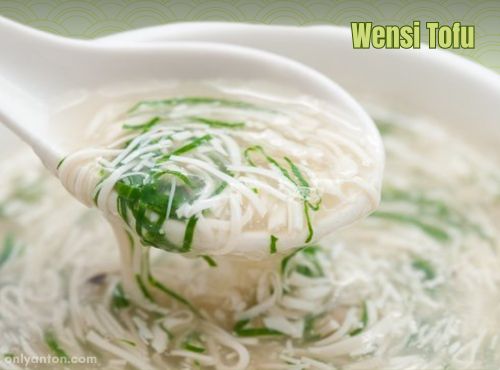
Wensi Tofu is perhaps the most striking example of Huaiyang cuisine’s legendary knife skills. In this dish, silken tofu is delicately shredded into hundreds of thin strands, resembling fine noodles. These delicate ribbons are then simmered in a clear broth, often with mushrooms, ham, and bamboo shoots. Created by a monk named Wensi during the Tang Dynasty, the dish embodies both culinary artistry and philosophical mindfulness, as it requires exceptional precision and patience to prepare.
4. Nanjing Salted Duck (南京盐水鸭, NánjīngYánshuǐ Yā)
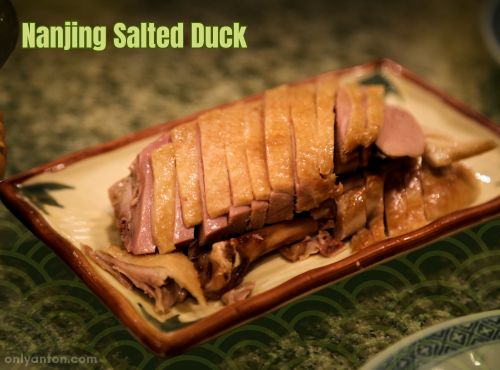
A specialty of Nanjing, this dish dates back to the Six Dynasties period and remains particularly popular during the autumn months, when the duck is at its most tender. The duck is first marinated in a seasoned brine, then either steamed or boiled until the meat becomes succulent and aromatic. Lightly salted with hints of ginger, star anise, and Sichuan pepper, the duck’s skin remains smooth and delicate, while the meat inside is moist and flavourful.
5. Squirrel Fish (松鼠桂鱼, Sōngshǔ Guìyú)
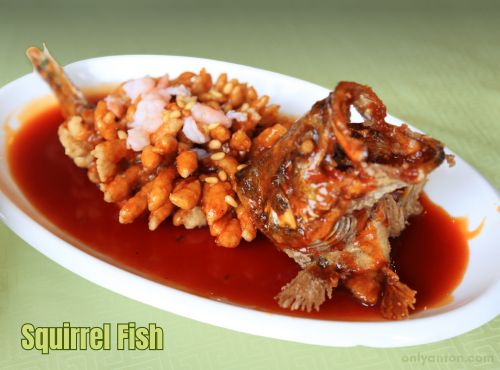
Combining culinary artistry with playful presentation, Squirrel Fish is a dish as visually striking as it is delicious. Chefs carefully debone a mandarin fish (桂鱼, guìyú) and carve it into the shape of a squirrel. The fish is then deep-fried until golden and crispy. It’s served topped with a glossy, sweet-and-sour sauce made from tomato paste, sugar, vinegar, and broth, garnished with pine nuts for added crunch. This dish is a banquet staple, symbolizing prosperity and abundance.
6. Beggar’s Chicken (叫花鸡, Jiàohuā Jī)
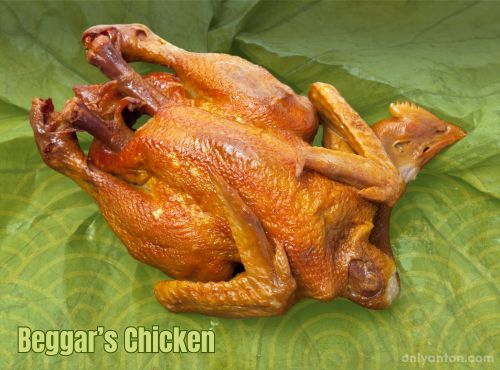
Legend has it that Beggar’s Chicken originated from a hungry beggar who wrapped a stolen chicken in lotus leaves and clay before roasting it over a fire. Today, fans of the dish celebrate it for the tender, aromatic meat infused with the fragrance of lotus leaves, soy sauce, Shaoxing wine, and spices. While traditionally baked in clay, modern versions often use foil for convenience. When cracked open at the table, the dish releases an intoxicating aroma, making it as theatrical as it is flavourful.
7. Duck Blood and Vermicelli Soup (鸭血粉丝汤, Yāxuè Fěnsī Tāng)
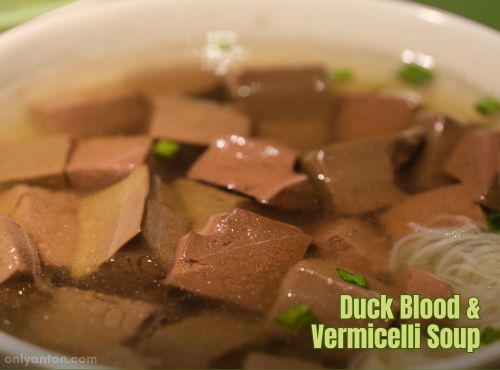
A Nanjing street-food classic, Duck Blood and Vermicelli Soup combines glass noodles, duck blood cubes, tofu, and offal in a rich, savoury broth. While the dish’s ingredients might seem intimidating to some, the broth’s hearty flavour and the silky texture of the duck blood make it a comforting and nourishing choice, especially during colder months. This dish reflects Jiangsu’s resourceful culinary ethos, where chefs try to use every part of an ingredient to create something both delicious and satisfying.
8. Stinky Tofu (臭豆腐, Chòu Dòufu)
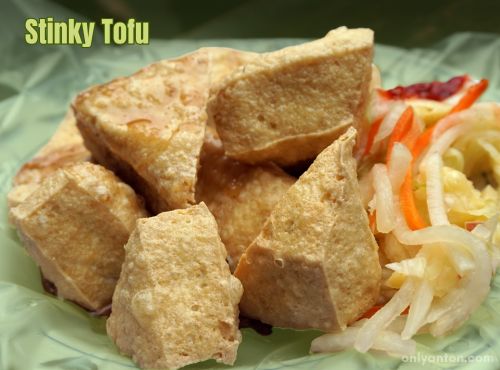
Though polarizing, Stinky Tofu is a beloved Jiangsu street snack, particularly in Nanjing. The tofu ferments in a brine made from vegetables and herbs and develops a pungent aroma that belies its rich, umami-packed flavour. The dish is fried until crispy and often topped with chilli sauce, pickled cabbage, and garlic.
I first encountered stinky tofu while teaching in Shaoxing, another cultural hub near Jiangsu. I was initially wary of the intense aroma wafting from street stalls, but curiosity got the better of me. Surprisingly, the crisp exterior gave way to a creamy, savoury interior. It is an acquired taste. Although it never became a go-to snack, I would occasionally sample different variants.
Each dish in Huaiyang cuisine reflects culinary skill and Jiangsu’s cultural heritage, transforming humble ingredients into elegant, memorable experiences. Whether enjoyed at a high-end banquet or a bustling street market, these iconic dishes define Jiangsu food’s light, refined, and seasonally driven character.
Jiangsu Cooking Techniques
The artistry of Huaiyang cuisine lies not just in its flavours but in the precision and skill that chefs apply to every stage of preparation. From knife work to cooking methods, each technique reflects the region’s emphasis on delicacy, balance, and visual elegance. These techniques are practical and integral to achieving Huaiyang cuisine’s signature lightness and refinement.
Precise Knife Work
Huaiyang cuisine is perhaps most famous for its exceptional knife skills. Chefs undergo rigorous training to cut ingredients into uniform shapes that enhance texture and presentation. This meticulous approach ensures that each bite offers consistent flavour and mouthfeel.
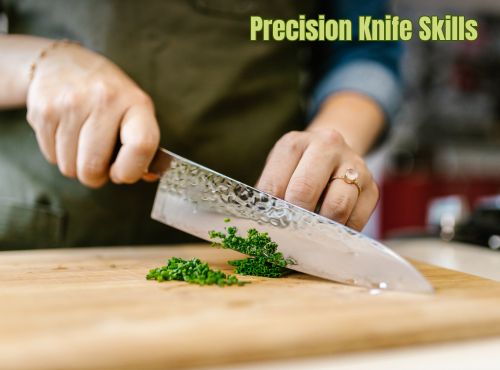
Dishes like Wensi Tofu (文思豆腐) exemplify this technique. Silken tofu is shredded into hair-thin strands, creating a delicate, noodle-like texture that floats gracefully in broth. Similarly, the intricate carving of Squirrel Fish transforms mandarin fish into an eye-catching, golden-fried centrepiece resembling a leaping squirrel.
Braising and Stewing
Braising (红烧, hóngshāo) is central to Huaiyang cooking. It allows ingredients to slowly absorb the flavours of a rich, savoury sauce while maintaining their tender texture. The process typically involves soy sauce, Shaoxing wine, sugar, and aromatic spices, resulting in a glossy, caramelized finish.
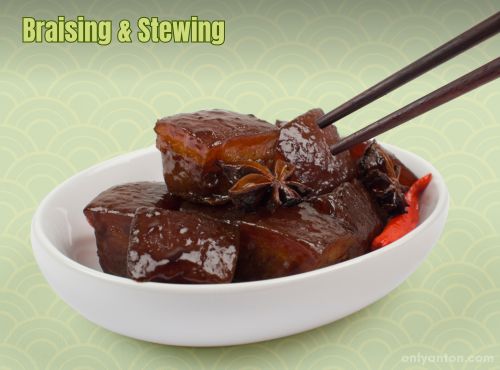
Lion’s Head Meatballs are gently braised until fork-tender. Red Braised Pork Belly (红烧肉, hóngshāo ròu) has melt-in-your-mouth layers of fat and lean meat. Both dishes are classic examples of this indulgent yet balanced technique.
Steaming

Steaming plays a vital role in Huaiyang cuisine. This method preserves the natural flavours, textures, and nutrients of delicate ingredients. Freshwater fish, dumplings, and seasonal vegetables are often steamed with ginger, scallions, and a drizzle of soy sauce, ensuring the dish remains light and healthy. Steamed Mandarin Fish, for example, highlights the clean taste of the fish, complemented by a fragrant soy-based dressing.
Simmering and Slow Cooking
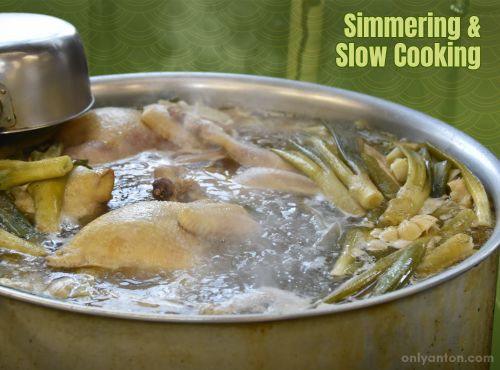
Gentle simmering allows Huaiyang chefs to achieve clear broths and tender textures in the creation of nourishing and elegant dishes. Chefs often employ this technique in soups and stews, such as the Duck Blood and Vermicelli Soup, where the broth remains pristine while developing deep, savoury complexity. Similarly, Beggar’s Chicken is traditionally wrapped in lotus leaves before baking. Slow cooking allows the aromatic spices to permeate the meat while keeping it juicy and flavourful.
Together, these techniques form the backbone of Huaiyang cuisine, transforming simple, seasonal ingredients into culinary masterpieces. Each dish reflects not just flavour but the dedication, precision, and artistry that define Jiangsu’s long culinary heritage.
Refinement and Presentation in Jiangsu Food
Huaiyang cuisine rose to prominence during the Qing Dynasty, becoming synonymous with imperial dining. Its emphasis on elegance and precision extended beyond taste. Dishes are crafted to please both the eye and the palate. Presentation became an art form, with meticulous knife work and harmonious plating reflecting the refinement expected in courtly settings. Emperors Kangxi and Qianlong were known for their southern tours along the Grand Canal. They frequently enjoyed Huaiyang delicacies, which further elevated the cuisine’s reputation.
Balance and Harmony
Aesthetic balance is central to Huaiyang cuisine. Symmetry, colour contrast, and seasonal garnishes elevate dishes into visual masterpieces. Every plate reflects a meticulous balance between taste, texture, and presentation. Wensi Tofu, for example, features silken tofu finely shredded into hair-thin strands, floating gracefully in a clear broth. Similarly, Squirrel Fish is carved into its iconic shape, fried to perfection, and coated with a glossy sweet-and-sour sauce. The result is a dish as visually striking as it is delicious.
Texture Emphasis
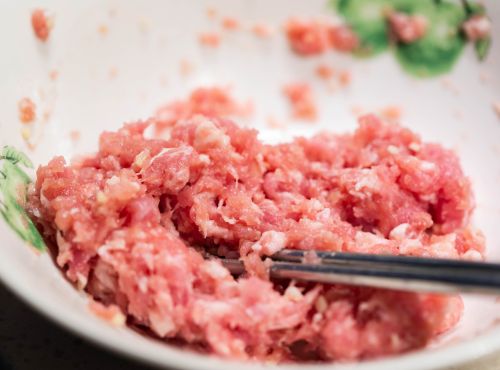
Chefs prize texture as much as flavour in Huaiyang cuisine. Dishes are prepared to achieve a soft yet firm consistency, ensuring tenderness without falling apart. Lion’s Head Meatballs exemplify this ideal. Achieving the desired texture involves finely mincing pork, often stirred in a single direction. This technique aligns the protein fibres, creating a cohesive yet tender structure that retains moisture and springiness. Fat content further enhances the mouthfeel. The addition of water chestnuts provides a subtle crunch, balancing softness with a satisfying bite.
Ultimately, Huaiyang cuisine embodies a culinary philosophy where form and function intertwine, transforming each dish into an edible work of art.
Jiangsu’s Culinary Influence and Modern Relevance
Huaiyang cuisine’s historical prestige extends into modern times. It remains the culinary standard for state banquets and official receptions. Its association with diplomacy was solidified when Huaiyang dishes were prominently featured in state dinners hosted by Chinese leaders, demonstrating culinary sophistication on the world stage. The emphasis on precise presentation, balanced flavours, and seasonal ingredients reflects China’s cultural values, making Huaiyang cuisine an ideal ambassador for formal dining.

Modern Popularity of Huaiyang Cuisine
Today, Huaiyang cuisine remains prominent in cities like Nanjing, Yangzhou, and Shanghai, where high-end restaurants celebrate its refined techniques and elegant dishes. In Nanjing, traditional eateries serve classics like Salted Duck and Duck Blood Soup, while Yangzhou’s vibrant culinary scene continues to perfect its famed fried rice. Shanghai, known for its cosmopolitan dining culture, embraces Huaiyang cuisine as a symbol of culinary excellence, with upscale restaurants offering tasting menus that showcase both heritage and innovation.
Fusion and Innovation
Contemporary chefs blend Huaiyang techniques with Western ingredients to create innovative dishes that maintain the cuisine’s refined principles while embracing global influences. Truffle-infused Yangzhou fried rice, foie gras-stuffed dumplings, and braised pork belly with red wine reduction are just a few examples of how tradition meets modern gastronomy. This fusion not only preserves the legacy of Huaiyang cuisine but also ensures its continued relevance in an ever-evolving culinary landscape.
Ultimately, Huaiyang cuisine’s enduring appeal lies in its ability to honour tradition while embracing innovation. It offers locals and international diners a taste of Jiangsu’s rich culinary heritage.
Conclusion
Huaiyang cuisine stands as a testament to the artistry and refinement of Chinese culinary traditions. Its light, elegant flavours, seasonal ingredients, and meticulous knife work create dishes that are as visually stunning as they are delicious. From the delicate strands of Wensi Tofu to the rich braise of Lion’s Head Meatballs and the iconic Yangzhou Fried Rice, Huaiyang cuisine exemplifies balance, precision, and harmony. Whether served at state banquets or in modern fine-dining establishments, it continues to represent the pinnacle of Chinese culinary craftsmanship.
Looking ahead, the next installment in the Great Traditions of Chinese Cuisine series will explore Anhui Food: The Great Tradition of Hui Cuisine. Hui cuisine is known for its hearty braises, wild mountain ingredients, and rustic yet flavourful dishes, contrasting with the refined elegance of Huaiyang cooking.
What About You?
Have you ever tried Huaiyang cuisine? What were your impressions? Do you have a favourite dish, like Yangzhou Fried Rice, Nanjing Salted Duck, or even the adventurous Stinky Tofu? Share your thoughts in the comments! If you enjoyed this post, be sure to check out my previous entries in the series, including Sichuan Food, Shandong Food, and Cantonese Food.
Further Reading and Resources
Related Blog Posts on Only Anton
- Chinese Cuisine: The Eight Great Traditions: Explore the Eight Great Traditions of Chinese Cuisine, from Anhui to Zhejiang, and discover China’s regional culinary heritage.
- Sichuan Food: The Great Tradition of Chuan Cuisine: Discover the bold flavours and spicy mala sensations of Sichuan cuisine, from Mapo Tofu to Hotpot. A must-read for food lovers!
- Shandong Food: The Great Tradition of Lu Cuisine: Shandong cuisine showcases fresh ingredients, aromatic flavours, and rich braised dishes with cultural and historical significance.
- Cantonese Food: The Great Tradition of Yue Cuisine: Cantonese food, renowned for fresh ingredients, delicate flavours, and global appeal, bridges tradition and innovation in Chinese cuisine.
- The Eight Great Tastes of Chinese Cuisine: A deep dive into the primary flavours that underpin the Eight Great Traditions.
External Resources
Books
- Land of Fish and Rice: Recipes from the Culinary Heart of China by Fuchsia Dunlop (2016): An essential read for understanding Jiangsu’s rich culinary landscape, with historical insights, personal anecdotes, and authentic recipes. Find it at your library, browse online, or grab your copy here.
- The Food of China by E. N. Anderson (revised ed., 1990): A scholarly yet accessible exploration of Chinese food culture, including insights into Huaiyang cuisine. Discover it at your library, look it up online, or purchase your copy here.
- The Food and Cooking of Shanghai and East China by Terry Tan (2013) explores the rich culinary traditions of Jiangsu, Zhejiang, and Shanghai, highlighting regional specialties, cooking techniques, and the cultural influences that shape East China’s distinctive cuisine. Look it up at a local library, browse online, or buy your copy here.
Guides and Articles
- China Discovery: Jiangsu Travel Guide: An informative guide to Jiangsu province, covering its history, cultural heritage, major cities, and culinary highlights, including Huaiyang cuisine.
- “Jiangsu Cuisine—Refined Healthy Gourmet Food,” China Highlights: A detailed overview of Jiangsu cuisine, emphasizing its refined cooking techniques, balanced flavours, and representative dishes such as Lion’s Head Meatballs and Squirrel Fish. Read the article here.
- “Discover the Art of Huaiyang Cuisine,” by Jocelyn Tan, Epicure (Asia) (February 2025): A deep dive into Huaiyang cuisine’s culinary philosophy, signature dishes, and its role in fine dining, featuring insights from expert chefs. Find the article here.
YouTube Channels and Videos
- Chinese Cooking Demystified: A channel offering step-by-step tutorials on authentic Chinese dishes, including Huaiyang classics.
- “Lion’s Head Meatballs—How to Make Huaiyang Braised Pork Meatballs” by Chinese Cooking Demystified: A practical demonstration of one of Huaiyang cuisine’s most iconic dishes. Find the video here.
- “How to Make Chinese Sweet and Sour Squirrel Fish,” The Woks of Life: A step-by-step cooking tutorial demonstrating the preparation of Squirrel Fish, a signature Jiangsu dish, including knife techniques, deep-frying methods, and the classic sweet-and-sour sauce. Watch the video here.





Hello! I hope you’re having a great day. Good luck 🙂
Thanks very much. Have a great day too!